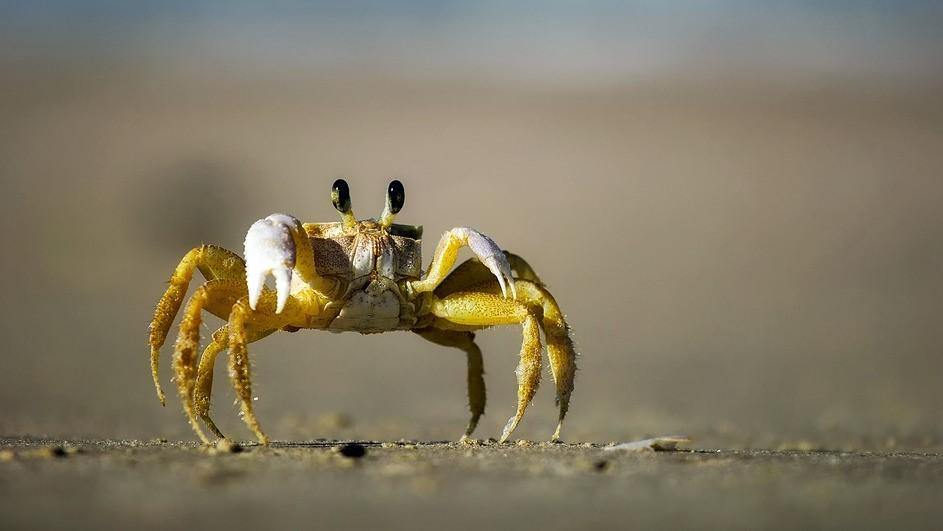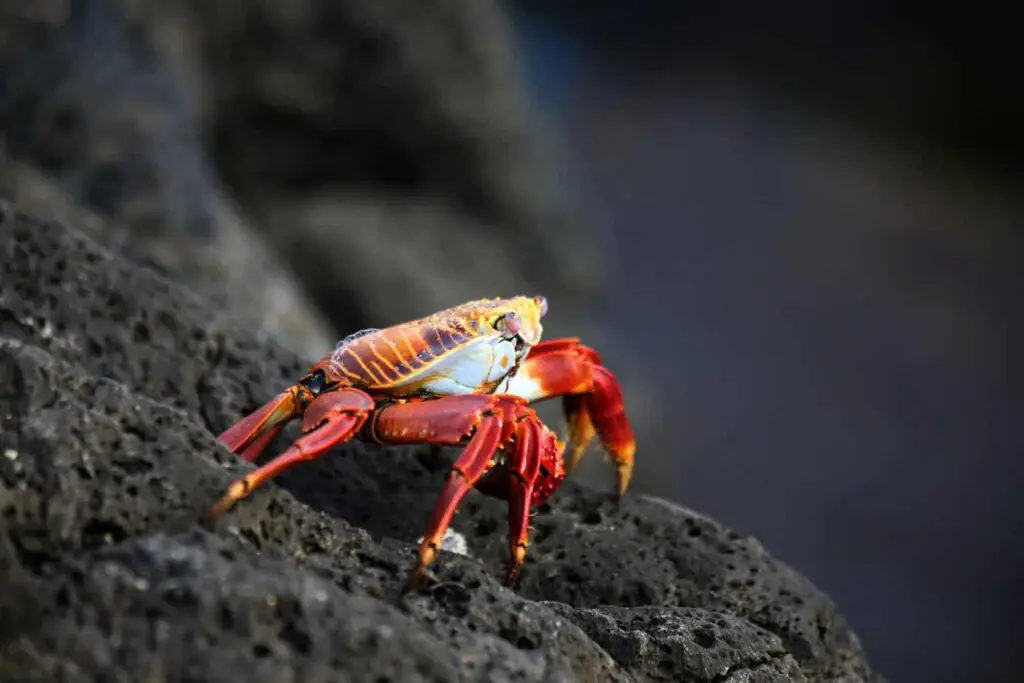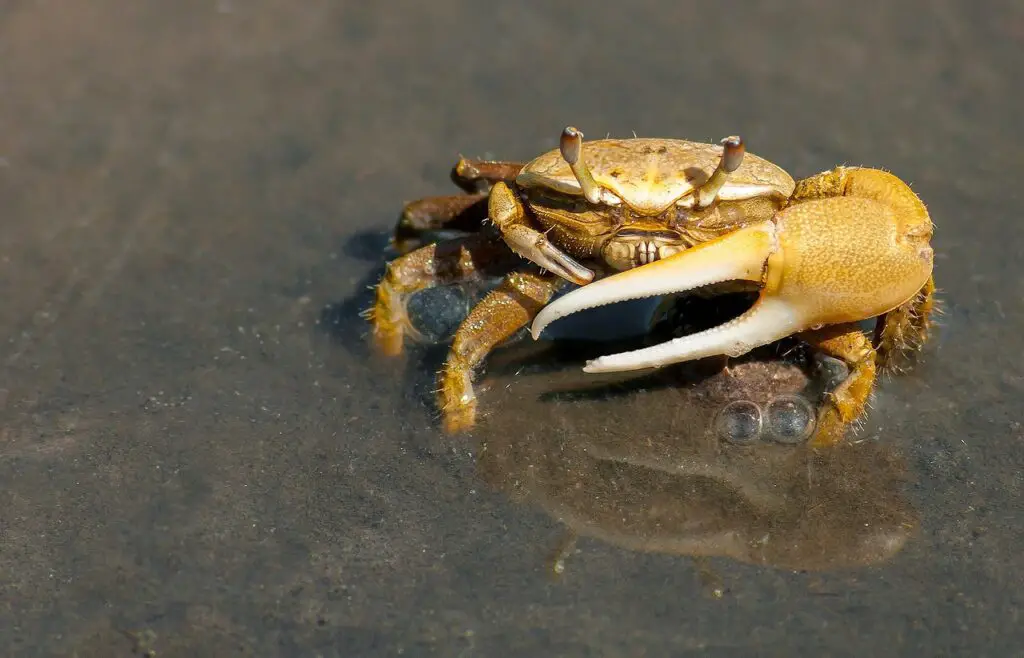Can Crabs Swim

Introduction
Can Crabs Swim: The world beneath the waves is a realm of mystery and wonder, filled with a vast array of marine life. Among the creatures that inhabit these aquatic environments, crabs hold a unique place. These fascinating crustaceans are known for their distinctive appearance, agile movements, and remarkable adaptations to their underwater homes.
Crabs are primarily associated with scuttling along the seafloor or crawling across rocky shores. Their powerful pincers and tough exoskeletons make them well-suited for such terrestrial-like locomotion. However, the true extent of their aquatic abilities has long intrigued scientists and enthusiasts alike.
We delve into the intriguing world of crab locomotion. We will investigate the various methods these creatures employ to navigate through water, whether it be for hunting, escaping predators, or simply moving to a new location. From specialized appendages to clever behavioral adaptations, crabs have evolved an impressive array of techniques to thrive in their submerged habitats.
Join us on this journey as we unlock the secrets of whether crabs can indeed swim or if their aquatic prowess lies in more unexpected mechanisms. By unraveling this mystery, we gain a deeper understanding of the complex and diverse strategies employed by marine life to survive and thrive in the world’s oceans.

Can a crab swim?
Some crabs swim. Most crabs, like stone crabs and spider crabs, walk or run across the bottom. However, crabs in the family Portunidae have specially modified back legs called swimmerettes. These paddle-shaped legs rotate at 20 to 40 revolutions per minute, allowing the crab to quickly swim through the water.
The question of whether a crab can swim may seem straightforward, but the answer is not as simple as a yes or no. Crabs are primarily adapted for life on the ocean floor or along shorelines, and their distinctive anatomy reflects this. They have powerful legs and claws designed for walking and climbing, rather than fins for propulsion through water like fish. However, crabs are not entirely incapable of swimming.
Some crab species have developed unique adaptations that allow them to move through the water effectively. For example, the aptly named “swimmer crabs” possess paddle-like appendages on their rear legs, which they use to propel themselves through the water with surprising grace and agility. These adaptations make them proficient swimmers when needed.
Additionally, crabs can use buoyancy and control over their body position to hover or move short distances above the ocean floor. While they may not swim in the traditional sense, their ability to navigate the water column to some extent showcases their versatility and adaptability in their underwater habitats.
While crabs are not known for swimming like fish, their unique adaptations and behaviors allow them to move through the water in their own distinct ways when required, adding another layer of intrigue to these fascinating crustaceans.
Are there crabs that can’t swim?
Coconut crabs are a type of hermit crab and are the world’s largest terrestrial arthropod (up to 3 feet across!). Unlike most other hermit crabs, only juveniles use shells to protect their abdomens; older coconut crabs develop a hard skin. They cannot swim, and will drown if immersed in water for long.
Indeed, there are many crab species that cannot swim in the conventional sense. The majority of crabs are adapted for a benthic, or bottom-dwelling, lifestyle. These crabs have evolved with specialized legs and body structures that excel at crawling, burrowing, and walking on the ocean floor or along coastal surfaces.
These non-swimming crabs rely on their ability to scuttle across the substrate, dig burrows, and navigate rocky terrain. They are often seen as expert scavengers, opportunistic predators, or filter-feeders, depending on their species and habitat.
While some crab species, like swimmer crabs, have developed adaptations for swimming, they are the exception rather than the rule. Most crabs are specialized for life in their specific ecological niche, whether it’s on the ocean floor, in tidal pools, or along coastal shores. Their diversity in form and function showcases the incredible adaptability of these creatures to various marine environments and highlights the fascinating range of strategies they employ to thrive in their respective habitats.
Do crabs have swim bladders?
However, several later studies, coupled with the fact that marine invertebrates do not have swim bladders, clearly suggest that the crab is more sensitive to vibration or particle motion.
Swim bladders are specialized gas-filled organs found in some bony fish that help them control their buoyancy and maintain their position in the water column. These organs allow fish to adjust their depth without expending much energy, making it easier for them to stay afloat or dive to different depths.
Crabs, on the other hand, are crustaceans and belong to a different group of animals than fish. They have a different body structure and respiratory system. Instead of swim bladders, crabs rely on various adaptations and behaviors to control their buoyancy and move in the water.
Many crab species are bottom-dwelling creatures that primarily crawl or scuttle along the ocean floor. Their legs and body structures are adapted for walking and digging, rather than for buoyancy control or swimming. Some crabs, such as swimmer crabs, have specialized paddle-like appendages that allow them to move more efficiently through the water, but they do not possess swim bladders.
Crabs do not possess swim bladders, as these structures are unique to bony fish and are not found in crustaceans like crabs. Crabs have evolved their own set of adaptations and behaviors to thrive in their aquatic environments.
Do crabs go in water?
Other crabs, like blue crabs, are primarily aquatic and are adapted to receiving their oxygen from the surrounding water. Yet, they can still survive for 1-2 days out of the water. The European green crab is a species infamous for surviving out of water for a long time—at least a week.
Crabs are aquatic creatures, and water is their natural habitat. They are found in a variety of aquatic environments, including oceans, seas, rivers, lakes, and even freshwater streams. Crabs are well-adapted to living in water, and their anatomy and behaviors reflect their aquatic lifestyle.
Most crab species are primarily bottom-dwellers, which means they are commonly found on the ocean floor, along coastlines, or in freshwater bodies. They have evolved specialized adaptations for life in these aquatic environments, such as powerful legs for crawling and digging, as well as modified gills for extracting oxygen from water.
Crabs are not only comfortable in the water but also rely on it for various aspects of their life cycle. They use water for respiration, reproduction, and finding food. Some crab species are excellent swimmers, using paddle-like appendages to move through the water with grace and speed.
While crabs are predominantly aquatic, they may venture onto land for brief periods, especially during the breeding season or when searching for a new habitat. However, they are primarily creatures of the water and are best suited to the challenges and opportunities of their watery world.
Do crabs have lungs?
Land crabs have a sort of lung, made from a modified gill chamber. Functional gills are rudimentary or absent. The coconut crab is an example: this huge crab is related to hermit crabs but it is terrestrial, using lungs to breathe.
Crabs do not have lungs like mammals or some other terrestrial animals. Instead, they have a specialized respiratory system adapted for their aquatic lifestyle. Crabs, like other crustaceans, use gills to extract oxygen from the water.
The gills of a crab are located in a cavity known as the branchial chamber, which is protected by the carapace, the hard outer shell of the crab. Water is drawn into the branchial chamber through openings called gill slits. As water passes over the gills, oxygen is absorbed from the water, and carbon dioxide is expelled. The oxygen is then transported through the crab’s circulatory system to be distributed to the body’s tissues.
This efficient system allows crabs to extract oxygen from the surrounding water, making them well-suited to their aquatic environment. However, it also means that crabs are reliant on water for respiration, and they must maintain a certain level of moisture to survive.
Crabs do not have lungs but instead utilize gills to extract oxygen from water. This adaptation is a key feature of their biology that enables them to thrive in their underwater habitats.
How do crabs move in the water?
Crabs exhibit a fascinating array of movements in the water, each adapted to their specific needs and the challenges of their aquatic environment. While they may not swim like fish, they have evolved several effective techniques for navigating through water:
Walking: Many crab species are well-suited for walking along the ocean floor or along coastal surfaces. They use their jointed legs and claws to scuttle and explore their underwater world.
Crawling: Crabs are expert crawlers, using their legs to move across the substrate. Their strong pincers help them grip and navigate rocky terrain or debris on the ocean floor.
Burying: Some crabs are burrowers, using their legs and claws to dig into the sand or mud at the bottom of the water. This behavior provides them with protection and helps them hunt for prey.
Swimmer crabs: Certain crab species, such as swimmer crabs, have specialized paddle-like appendages on their rear legs. These adaptations allow them to paddle through the water with remarkable agility, resembling a swimming motion.
Buoyancy control: Crabs can manipulate their buoyancy by trapping air or water in cavities within their bodies. This allows them to hover above the substrate or move short distances above the ocean floor.
Jet propulsion: Some crabs, like the box crab, expel water forcefully from their gill chambers to move rapidly in reverse. This burst of water acts as a form of jet propulsion, allowing them to escape predators or catch prey.
Crabs exhibit a diverse range of movements in the water, using a combination of their legs, claws, specialized appendages, and clever adaptations to thrive in their underwater habitats. These unique locomotion strategies highlight the versatility of these crustaceans in navigating their aquatic world.
Do all crabs live in water?
While it’s true that many crab species are aquatic and inhabit marine or freshwater environments, there are also terrestrial crabs that have adapted to life on land. The world of crabs is diverse, with approximately 7,000 known species, and they have evolved to thrive in various ecological niches.
Aquatic crabs are commonly found in oceans, rivers, and lakes, and they are well-known for their ability to swim and breathe underwater using specialized gills. They are adapted to a life in water, using their pincers for hunting, defense, and burrowing in sandy or rocky substrates.
In contrast, terrestrial crabs have made adaptations to suit life on land. These crabs have lungs or modified gills that allow them to breathe air instead of water. They are often found in coastal regions, forests, and even deserts, where they have developed unique behaviors and characteristics to survive in their respective environments.
Crabs exhibit a wide range of lifestyles, and while many are aquatic, there are indeed crabs that have successfully adapted to living on land, showcasing the remarkable adaptability of this diverse group of crustaceans.
Are crabs good swimmers compared to other aquatic animals?
Crabs, in general, are not known for their exceptional swimming abilities compared to other aquatic animals. While they are certainly adapted to life in the water and can move through it efficiently, they are not typically considered strong or agile swimmers when compared to creatures like fish or dolphins.
Crabs have a distinctive body structure, with a hard exoskeleton and a pair of pincers, which make them better suited for other activities, such as crawling along the ocean floor, burrowing into sandy or rocky substrates, or navigating through the shallows. Their swimming capabilities vary among species, with some crabs being better swimmers than others. For example, the blue crab is known for its swimming prowess, using powerful paddle-like appendages to move through the water.
When compared to animals like fish, which have streamlined bodies and specialized fins for propulsion, crabs may seem less proficient in swimming. Fish are highly adapted to life in the water, capable of rapid and precise movements in three dimensions.
While crabs are adapted to their aquatic habitats and can swim to some extent, they are not typically considered exceptional swimmers compared to many other aquatic animals that have evolved for more efficient and agile movement in the water.

Conclusion
Our exploration into the swimming capabilities of crabs shed light on the remarkable adaptations of these crustaceans to their aquatic environments. While crabs may not swim in the traditional sense like fish or dolphins, they have demonstrated a range of ingenious methods to navigate the water with impressive agility and purpose.
From the paddling of their specialized appendages to their clever use of buoyancy and jet propulsion, crabs have evolved diverse strategies for survival. Some species, like the graceful swimmer crab, have even mastered elegant swimming techniques that allow them to glide gracefully through the water.
The ability to swim, or at least move efficiently in water, is crucial for crabs. It aids in foraging, escaping predators, finding mates, and seeking new habitats. It is a testament to the adaptability and versatility of these creatures, showcasing how they have thrived in a wide range of marine ecosystems.
While crabs may not be known for their swimming prowess in the conventional sense, they have evolved a fascinating array of mechanisms to navigate the aquatic realm. These adaptations emphasize the incredible diversity of life in the oceans and remind us of the ongoing mysteries and marvels waiting to be discovered beneath the waves. Our journey into the world of crab locomotion has provided a deeper appreciation for the complexity of nature’s solutions to the challenges of underwater existence.



